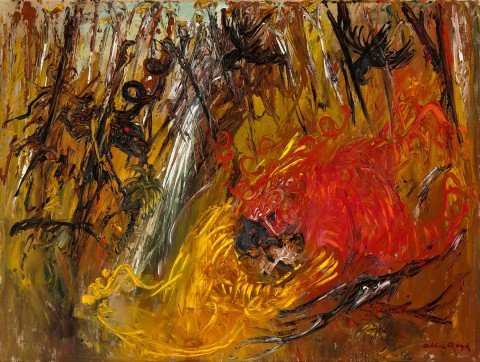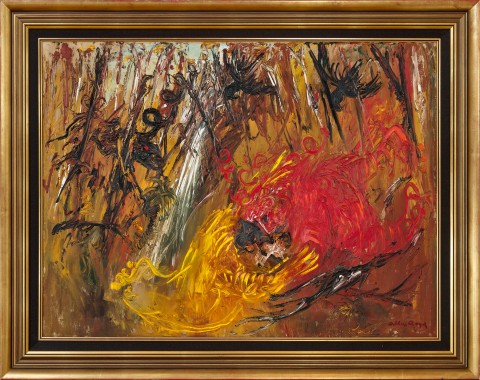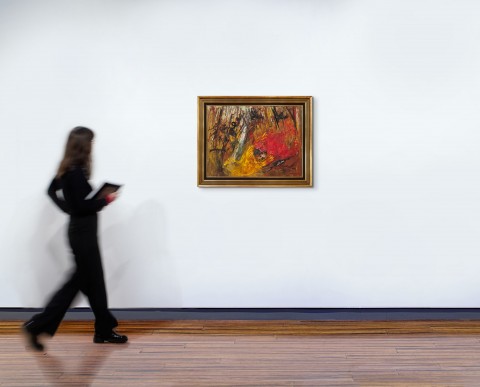RETURN OF THE PRODIGAL SON, c.1968
ARTHUR BOYD
oil on canvas
76.5 x 102.0 cm
signed lower right: Arthur Boyd
bears inscription verso “RETURN OF THE PRODIGAL SON”
Private collection
Sir Leon and Lady Trout, Brisbane
The collection of Sir Leon and Lady Trout, Christie's, Brisbane, 6 June 1989, lot 164 (as 'Nebuchadnezzar')
Henry and Dinah Krongold, Melbourne
The Estate of Paul Krongold, Melbourne
As a cautionary tale of extravagance, destitution, reconciliation and final redemption, the parable of the Prodigal Son clearly held great appeal for Arthur Boyd who revisited the theme at multiple points throughout his vast and varied oeuvre. Embedded in his imagination from an early age through the ritual reading of biblical stories to him by his grandmother, Emma Minnie Boyd (1858 – 1963)1, significantly such preoccupation was augmented during the mid to late forties by the artist’s study of Old Master reproductions, and in particular, the extensive Rembrandt print collection housed in the National Gallery of Victoria.2 Culminating most famously in his seminal mural cycle at the Harkaway family property, The Grange, commissioned in 1948 by his uncle Martin Boyd (who himself had returned to the family fold after an absence of 27 years), indeed these early iterations of the theme eloquently attest to the fusion of the sacred with the deeply personal in Boyd’s art, with such ancient biblical stories invariably transformed into ciphers of modern life.
Recounted in the Gospel of Luke, the parable of the Prodigal Son narrates the tale of a son who beseeched his father to bequeath him his share of the family estate early so he could travel and make his fortune. Seduced by worldly vices in foreign lands, thus he subsequently squandered his wealth on wild living, falling into poverty and forced to become a swineherd. Starving and repentant, the son eventually returns to his father seeking forgiveness, which is readily granted by the magnanimous patriarch. Featuring this joyful reunion of father and son, the present painting nevertheless encapsulates a marked departure from Boyd’s earlier, Old Master-inspired treatment of the episode – both in its iconography and stylistic approach. Offering a highly expressive, gestural interpretation that employs several signature motifs all fused within a rolling bush landscape, the composition would seem, rather, more reminiscent of the artist’s iconic Nebuchadnezzar series which he commenced in 1966 and exhibited in Australia and the United Kingdom in 1968 and 1969 respectively.
Of particular relevance are Boyd’s depictions of Nebuchadnezzar which vividly evoke the descent of the King of Babylon’s descent into madness – witness for example, Nebuchadnezzar Running in a Forest with Lion and Black Birds which bears affinities with the present work in its overall composition of dense shrubland, the abstract fusion of figurative elements with natural surrounds, and inclusion of motifs such as the curly-horned ram, ominous black birds and the figure in red.3 Moreover, as in the Nebuchadnezzar series, here the bush similarly becomes a site of intense psychological anxiety, a space of moral degeneration and fall from grace. With its litany of personal symbols, interconnection of elements and energetic handling, thus Return of the Prodigal Son, c.1968 exemplifies superbly Boyd’s singular talent for capturing man, beast and nature caught up in the same expressive maelstrom of strange and malevolent energies. Like the most successful of his biblical narratives, the composition abandons logic to invoke a mythic, spiritual dimension and enigmatic resonance that far transcends pure representation.
1. Hoff, U., The Art of Arthur Boyd, Andre Deutsch, London, 1986, p. 83
2. Philipp, F., Arthur Boyd, Thames and Hudson, London, 1967, pp. 47 – 48
3. For an illustration of the work, see Boase, T.S.R., Nebuchadnezzar, 34 paintings and 18 drawings by Arthur Boyd, Thames and Hudson, London, 1972, pl. 28
VERONICA ANGELATOS


